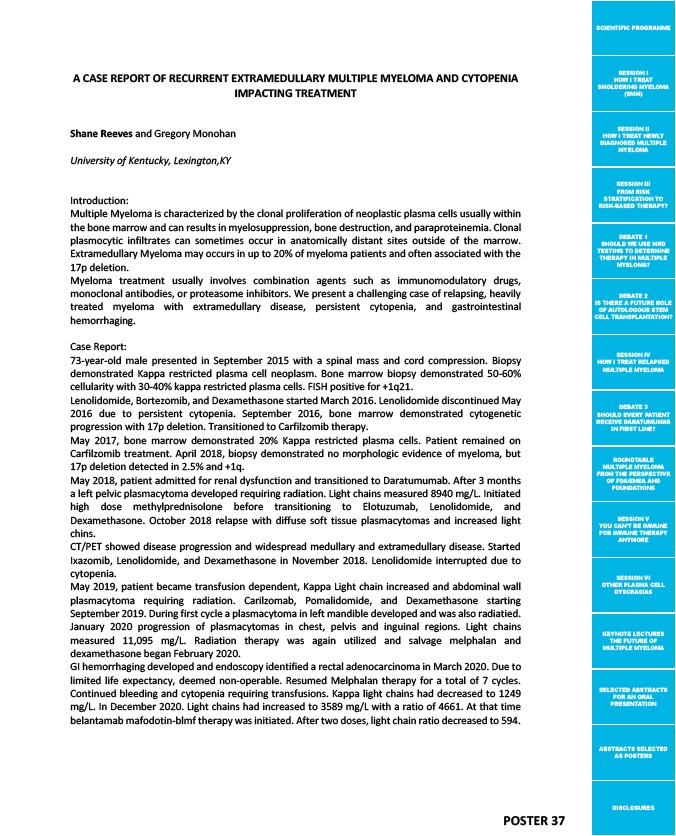
SCIENTIFIC PROGRAMME
SESSION I
HOW I TREAT
SMOLDERING MYELOMA
(SMM)
SESSION II
HOW I TREAT NEWLY
DIAGNOSED MULTIPLE
MYELOMA
SESSION III
FROM RISK
STRATIFICATION TO
RISK-BASED THERAPY?
DEBATE 1
SHOULD WE USE MRD
TESTING TO DETERMINE
THERAPY IN MULTIPLE
MYELOMA?
DEBATE 2
IS THERE A FUTURE ROLE
OF AUTOLOGOUS STEM
CELL TRANSPLANTATION?
SESSION IV
HOW I TREAT RELAPSED
MULTIPLE MYELOMA
DEBATE 3
SHOULD EVERY PATIENT
RECEIVE DARATUMUMAB
IN FIRST LINE?
ROUNDTABLE
MULTIPLE MYELOMA
FROM THE PERSPECTIVE
OF FDA/EMEA AND
FOUNDATIONS
SESSION V
YOU CAN’T BE IMMUNE
FOR IMMUNE THERAPY
ANYMORE
SESSION VI
OTHER PLASMA CELL
DYSCRASIAS
KEYNOTE LECTURES
THE FUTURE OF
MULTIPLE MYELOMA
SELECTED ABSTRACTS
FOR AN ORAL
PRESENTATION
ABSTRACTS SELECTED
AS POSTERS
DISCLOSURES
A CASE REPORT OF RECURRENT EXTRAMEDULLARY MULTIPLE MYELOMA AND CYTOPENIA
POSTER 37
IMPACTING TREATMENT
Shane Reeves and Gregory Monohan
University of Kentucky, Lexington,KY
Introduction:
Multiple Myeloma is characterized by the clonal proliferation of neoplastic plasma cells usually within
the bone marrow and can results in myelosuppression, bone destruction, and paraproteinemia. Clonal
plasmocytic infiltrates can sometimes occur in anatomically distant sites outside of the marrow.
Extramedullary Myeloma may occurs in up to 20% of myeloma patients and often associated with the
17p deletion.
Myeloma treatment usually involves combination agents such as immunomodulatory drugs,
monoclonal antibodies, or proteasome inhibitors. We present a challenging case of relapsing, heavily
treated myeloma with extramedullary disease, persistent cytopenia, and gastrointestinal
hemorrhaging.
Case Report:
73-year-old male presented in September 2015 with a spinal mass and cord compression. Biopsy
demonstrated Kappa restricted plasma cell neoplasm. Bone marrow biopsy demonstrated 50-60%
cellularity with 30-40% kappa restricted plasma cells. FISH positive for +1q21.
Lenolidomide, Bortezomib, and Dexamethasone started March 2016. Lenolidomide discontinued May
2016 due to persistent cytopenia. September 2016, bone marrow demonstrated cytogenetic
progression with 17p deletion. Transitioned to Carfilzomib therapy.
May 2017, bone marrow demonstrated 20% Kappa restricted plasma cells. Patient remained on
Carfilzomib treatment. April 2018, biopsy demonstrated no morphologic evidence of myeloma, but
17p deletion detected in 2.5% and +1q.
May 2018, patient admitted for renal dysfunction and transitioned to Daratumumab. After 3 months
a left pelvic plasmacytoma developed requiring radiation. Light chains measured 8940 mg/L. Initiated
high dose methylprednisolone before transitioning to Elotuzumab, Lenolidomide, and
Dexamethasone. October 2018 relapse with diffuse soft tissue plasmacytomas and increased light
chins.
CT/PET showed disease progression and widespread medullary and extramedullary disease. Started
Ixazomib, Lenolidomide, and Dexamethasone in November 2018. Lenolidomide interrupted due to
cytopenia.
May 2019, patient became transfusion dependent, Kappa Light chain increased and abdominal wall
plasmacytoma requiring radiation. Carilzomab, Pomalidomide, and Dexamethasone starting
September 2019. During first cycle a plasmacytoma in left mandible developed and was also radiatied.
January 2020 progression of plasmacytomas in chest, pelvis and inguinal regions. Light chains
measured 11,095 mg/L. Radiation therapy was again utilized and salvage melphalan and
dexamethasone began February 2020.
GI hemorrhaging developed and endoscopy identified a rectal adenocarcinoma in March 2020. Due to
limited life expectancy, deemed non-operable. Resumed Melphalan therapy for a total of 7 cycles.
Continued bleeding and cytopenia requiring transfusions. Kappa light chains had decreased to 1249
mg/L. In December 2020. Light chains had increased to 3589 mg/L with a ratio of 4661. At that time
belantamab mafodotin-blmf therapy was initiated. After two doses, light chain ratio decreased to 594.